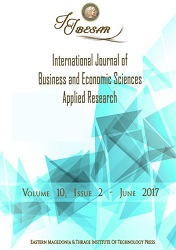Government Size and Quality of Governance: Does State Size Matter?
Government Size and Quality of Governance: Does State Size Matter?
Author(s): Primož PevcinSubject(s): Governance, Public Administration, Management and complex organizations
Published by: Τεχνολογικό Εκπαιδευτικό Ίδρυμα Ανατολικής Μακεδονίας και Θράκης
Keywords: Small states; Governance; Governmental interventionism; Public goods and services; Innovations; Great Lockdown;
Summary/Abstract: Purpose: Small state studies has emerged as a discipline, and this discipline has been initially dominated mainly by the issues of vulnerability and a lack of capacities of small states, although these issues have been gradually replaced by the discussions on the potential opportunities of small states, not just their challenges. Within this framework, the consideration needs to be done also on the effect of the state size on the economics, governance and public management, among others. Design/methodology/approach: The current theorizing in small state studies focuses on the specifics of the small economy modelling and governance. The existing economic literature has occasionally stressed the relations between the size of the state and size of government, but with rather mixed empirical results. Moreover, relations between state size and quality of governance has also been emerging issue. This study would like to integrate both approaches. The empirical research utilizes cross-national comparative investigation based on the data for 44 European states; and we specifically assess, in addition to the existing approaches, how budgetary and non-budgetary scope of government differentiates among smaller and larger states. Findings: The results of the study suggest that the effect of the size of the state does not necessary favour larger states in respect to the smaller size of government and quality of governance. Thus, although potential scale economies matter regarding the public services’ provision, the structure of spending, institutional context, and innovations in public service delivery modes also have the role in shaping scope and functions of the government, whereas quality of governance seems to be independent regarding the state size, at least in the European context. Research limitations/implications: Analysis is limited to the cluster of European states, and the results should be interpreted within this context. Originality/value: After the World War II the number of states has increased substantially, in fact, it has tripled. We are currently living in the era of small states, as more than one third of the existing two hundred and more states around the globe are actually small, if we assess the multiple criteria combination. In this context, this paper would like to add to the development of the field of small state studies.
Journal: International Journal of Business and Economic Sciences Applied Research (IJBESAR)
- Issue Year: 13/2020
- Issue No: 3
- Page Range: 7-14
- Page Count: 8
- Language: English

